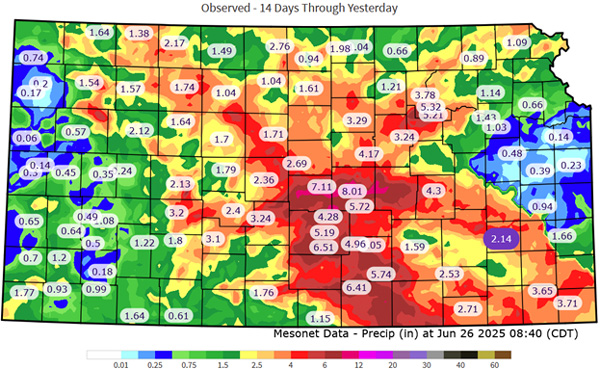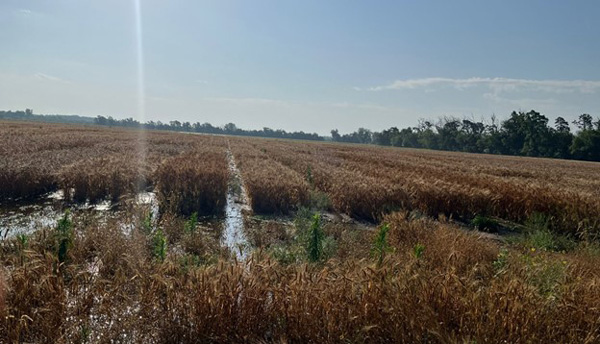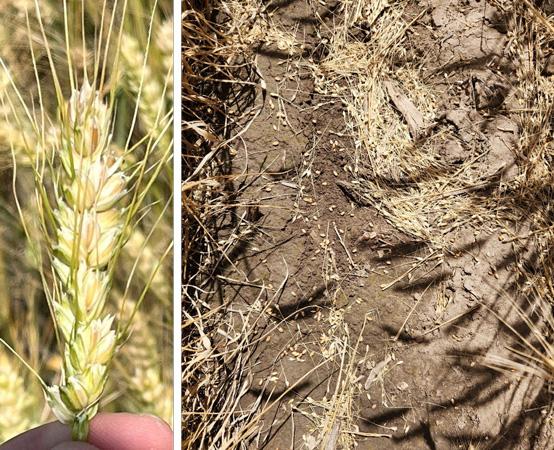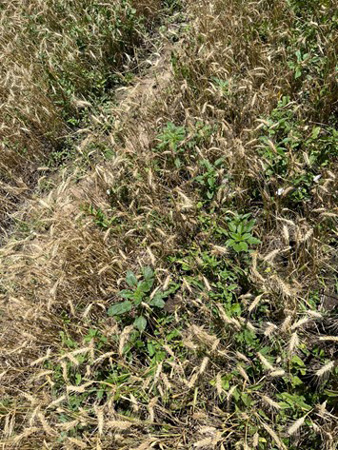The 2025 wheat harvest is off to a slow start in Kansas. According to the latest USDA report, as of June 23, about 20% of the Kansas wheat crop had been harvested, as compared to 49% in the previous year and to the 31% five-year average.
There are two main reasons for the slow progress of the Kansas wheat harvest this year. First, the wheat harvest started later than normal. It is not uncommon for parts of south central-southwest Kansas to start harvesting in the last few days of May or early June. Still, this year, harvest didn’t start until the second week of June. The reason for a later start to the wheat harvest this year was the cool and moist weather conditions during the month of May and early June, which slowed down crop development and prolonged the grain-filling period and crop cycle. Also contributing to the slow progress, many rainfall events across the state have slowed down the crop harvest since its start. Depending on the region within Kansas, the total rainfall accumulated in the last 14 days ranged from nearly null in west-central Kansas to as much as 8 inches in McPherson and Rice counties (Figure 1).

Figure 1. Cumulative rainfall during the 14-day period from June 12 to June 26, 2025, across Kansas. Source: mesonet.ksu.edu/precip/daily
These heavy rainfall conditions can have many consequences for the yield and quality of the wheat crop, especially since these storms were accompanied by very windy conditions. Some of these potential consequences include:
Yield reduction
- Waterlogging: Waterlogging has been a common theme in Kansas wheat in the last few days, in particular in parts of south-central Kansas that received large precipitation amounts (Figure 2). Waterlogged soils are depleted of oxygen in the root zone and can affect physiological processes in the crop, very detrimental to wheat that is still going through the grain filling period. While wheat can handle a couple of days of flooding, prolonged exposure to these anaerobic conditions can lead to crop damage. Some earlier waterlogging (during grain filling) occurred in parts of the state this year, in particular central Kansas (Salina region) and parts of western Kansas (Dighton region). Late-season waterlogging, such as the one caused by these recent storms during the last couple of weeks, has precluded growers from entering the field to progress on wheat harvest due to extremely wet soils and can lead to a greater incidence of saprophytic fungi.

Figure 2. Wheat field ready to harvest, however, with standing water due to recent rains near Hutchinson, Kansas. Photo by Luiz Pradella, K-State doctoral student, taken on June 24, 2025.
- Lodging: As we covered in detail in the last edition of the Agronomy eUpdate, these recent rainfall events resulted in lodged wheat across much of the state (https://bit.ly/45y0y8J). The earlier lodging occurs in the wheat cycle, the more likely it is to cause yield loss. This is because, among many reasons, it can disrupt the translocation of synthesized sugars to the developing grain and create a microclimate that can lead to greater severity of diseases. This is not the case for this year’s crop, since lodging occurred later in the season when the grain was either already mature or very close to it. Still, late-season lodging can reduce grain yield by creating difficulties in harvesting the crop, as outlined in our previous article.
- Grain shattering: During the 2025 wheat season, the cool and moist grain fill conditions led to large and heavy kernels, and some varieties were showing opened glumes prior to harvest (Figure 3, left panel), which makes the grain more prone to shattering. Wetting a mature wheat head leads to swollen grains (see Grain quality reduction section below), which may further open and weaken the glumes and make grain shattering more likely. Thus, these conditions were worsened by the heavy rains after the crop matured, and when combined with high winds, led to grain shattering across many wheat fields (Figure 3, right panel). How tightly the glume holds to the seed during grain dry down is referred to as glume tenacity, and varieties show different levels of tenacity. Once conditions for harvest resume, growers should prioritize harvesting of fields of varieties with known low glume tenacity (for example, varieties that are known to shatter more easily such as WB Grainfield and LCS Valiant) as compared to varieties of high glume tenacity (for example, SY Wolverine) since they will be more prone to grain shattering.

Figure 3. Open wheat glumes prior to maturity (left panel; photo by north-central Kansas farmer Neil Beckemeyer, on June 10, 2025), and shattered wheat grain as the mature crop endures windy storms (right panel; photo by master's student Jazmin Gastaldi on June 26, 2025, near Hays, Kansas).
- Weed incidence: Late-season moisture combined with high temperatures favors greater weed incidence, especially since at this time the wheat crop is not taking up more water and therefore the available water can be fully used by the developing weeds. While weeds at this time do not cause direct yield loss due to competition for resources, they can cause harvest problems (for example, higher grain moisture, machinery clogging, etc.) and lead to higher impurities and dockage at grain delivery. In dense wheat canopies, shading may be enough to delay weed emergence and development until harvest is completed. However, weeds can become really problematic in thinner wheat canopies, such as those of fields impacted by wheat streak mosaic virus this season (Figure 4).
Depending on weed incidence, a pre-harvest herbicide application may be warranted to reduce the chances of problems during wheat harvest. See the accompanying eUpdate article about pre-harvest herbicide options and intervals.

Figure 4. Developing weeds in a thin canopy of a mature wheat crop. The thin canopy was partially due to the high incidence and severity of wheat streak mosaic virus. Photo by Luiz Pradella, doctoral student, taken June 19, 2025, near Russell, Kansas.
Quality reduction
- Decreased test weight: Rewetting of a ripe wheat grain prior to harvesting reduces test weight due to two main reasons.
- First, in a ripe wheat kernel, starch granules are densely packed together. Once these grains receive moisture, the starch granules absorb water and thus they swell (increase in volume). Upon drying again, these molecules lose water and reduce in volume, but they never become as compact as they were initially. This means that the kernel, which originally had a given weight in a given volume, now has the same weight, but in a greater volume. In other words, grains now have a lower density. Since test weight, measured in pounds per bushel, is the grain volume weight, it is decreased with pre-harvest rainfall events.
- Second, rewetting of the grain can reduce test weight through initiation of the germination process. This occurs when some of the starch starts to be digested, leaving small voids in the grain that reduce density. This year, some of the initial reports from growers and cooperatives were that the grain test weight was initially good (60-62 pounds per bushel); however, we started hearing reports of test weights as low as 57-58 pounds per bushel after some of these initial rains. Of course, different wheat varieties have different tendencies for test weight, some being above average and others naturally below average. But the message is that more pre-harvest rains could further reduce grain test weight.
- Pre-harvest sprouting: Pre-harvest sprouting is the germination of the grain while still within the head. For wheat seed to germinate, water must penetrate the seed coat and move into the seed, which is facilitated by multiple wetting and drying cycles. Recently mature wheat seeds are usually dormant, but the length of this dormancy period depends on the wheat variety, and the right conditions can initiate dormancy break. Periods such as the last two weeks, characterized by multiple rainfall events, high humidity, and high temperatures, increase the likelihood of dormancy break and consequent pre-harvest sprouting, especially when combined with the lack of genetic dormancy.
In extreme cases, it is possible to see developing roots and shoots of wheat while still in the head. However, even without visible sprouting symptoms, pre-harvest sprouting can lead to problems due to reduced test weight, leading to potential discounts at the elevator. The activity level of the alpha-amylase enzyme, responsible for breaking down starch during grain germination, can be indicated by the falling number metric, with lower falling numbers indicating more enzyme activity / more pre-harvest sprouting.
Wheat varieties with white seed-coat color tend to be more prone to pre-harvest sprouting than those with red seed-coat color, since the genes that control pre-harvest sprouting are associated with the genes for seed coat color. Thus, once conditions for harvesting are favorable again, growers should prioritize the harvest of white wheat fields since these would, in general, be more prone to pre-harvest sprouting than red wheat varieties.
- Opportunistic fungi and mycotoxin accumulation: Delays in harvest of a mature wheat crop can also lead to the growth of mold and other opportunistic fungi, leading to black point. Additionally, vomitoxin levels can increase in fields with high levels of Fusarium head blight. These issues were covered in detail in an article in the last edition of the Agronomy eUpdate (https://bit.ly/4na5rv2).
Romulo Lollato, Extension Wheat Specialist
lollato@ksu.edu
Chip Redmond, Assistant Meteorologist, Mesonet Manager
christopherredmond@ksu.edu
Tags: wheat late harvest wheat harvest